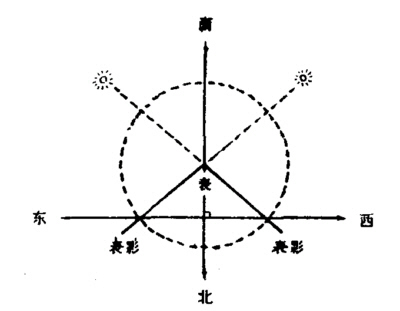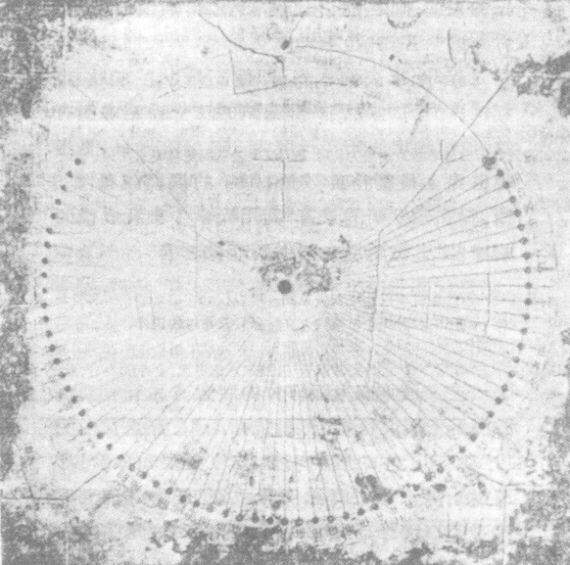Chapter 8 Chapter 3 Precision Astronomical Instruments
Every object casts a shadow under the sunlight, and as the sun moves across the sky, the direction and length of the shadow are constantly changing.Through long-term observation and accumulation, the ancients found that this change includes two cycles, one is a short cycle with a day and night as the unit, and the other is a long cycle with spring, summer, autumn and winter as a unit, which is in sync with phenological phenomena such as flowering and fruiting.About 4,000 years ago, the oldest known astronomical instrument—the watch—appeared.The generation of the table is convenient for more accurately judging the direction and length of the shadow.Obviously this watch does not refer to clocks or instruments, but there is an inevitable connection between the former and the latter.
A watch is a pole standing upright on the ground.Under the sun, where there is a pole, there will be a shadow. This is probably the original meaning of the idiom "immediate results".The words Gan, 槷 [nie Nie], Nie [nie Nie], Bi, stele, and Bei [bei stele] in ancient books are all other names for watches.
Although the structure of the table is simple, it has many functions.The original purpose of the table was to determine orientation.The sun does not rise due east and set due west every day.Taking the Beijing area (40°00′ geographical latitude) as an example, on the winter solstice day, the sun rises at about 31°south east and sets at about 31°south west, far away from east and west.Only around March 21 (vernal equinox) and September 23 (autumn equinox) every year can it be said that the sun really "rises in the east and sets in the west".So how to determine the direction by the surface shadow?In ancient times, an arbitrary circle was made with the stand as the center of the circle, and then the two points where the surface shadow intersected with the circle at sunrise and sunset were connected to obtain the due east and west directions, and the north and south were known from east to west (see Figure 5).In order to improve the measurement accuracy, it is also possible to draw a few more arbitrary circles and take the average value for multiple times.However, the surface shadow at sunrise and sunset is often blurred, and even if it is measured many times, it is inevitable that there will be large errors.If two equal-length surface shadows are used in the morning or afternoon, and the connection line between their endpoints is used, the east-west direction can also be known.Yuan Dynasty astronomer Guo Shoujing's directional instrument "Zheng Scheme" was designed using this principle.

Figure 5 Use the table to judge the direction
In addition to determining the orientation, the watch also has two important functions. One is to use the change in the direction of the surface shadow during the day to judge the time, and the other is to use the change in the length of the shadow at noon in a year to judge the winter solstice and summer solstice.The extension of the first function is that the watch has evolved into a sundial (gui turtle) by adding a round stone plate engraved with radial time lines.The result of the development of the second function led to the production of Guibiao, which was one of the indispensable astronomical instruments in ancient China.This section focuses on gui watches, and sundials will be left to the section on timing instruments.
In winter, the sun is more inclined than in summer, so the shadow is longer than in summer. In other words, on the day when the shadow is longest or shortest at noon, the sun is at the extreme south or north.These two days are called the winter solstice and the summer solstice respectively (see Figure 6).Experience tells people that when the sun leaves the southernmost point and starts to move north, the weather will gradually become warmer and everything will gradually recover, which means that the famine will pass.Similarly, when the sun leaves the northernmost point and starts to move south, the weather gradually becomes colder and everything withers, which means that food for the winter must be stored as soon as possible, so the winter solstice and summer solstice are particularly important in the eyes of the ancients. Calculating the winter solstice and summer solstice has become one of the most basic contents in ancient Chinese astronomy.

Figure 6 Using the table to judge the winter solstice and summer solstice
The latitude of most parts of China is higher than the Tropic of Cancer (ie 23.5°), and the shadow of the surface at noon is always in the direction of the true north of the surface.Place a flat plate with a scale facing north next to the base of the watch, and you can directly read the length of the shadow at noon.Originally, the word "Gui" only refers to flake jade, because it was widely used as a standard ruler for measuring land, and later the tool for measuring shadow length was also called Gui, and the combination of Gui and Biao was called Guibiao (see Figure 7).
Whether the body of the watch is vertical or not, and whether the surface of the guilloche is horizontal, will affect the length of the shadow of the watch, so people in the Han Dynasty knew that the verticality of the watch was corrected with the help of hanging objects, and the level of the guilloche was corrected with the help of a water tank.In addition, in order to overcome the difficulties caused by the blurring of the end line of the shadow caused by light diffusion, Shen Kuo proposed two improvements in the seventh year of Song Xining (AD 1074): one is to place the guibiao on a table with only a gap at the top. Because there is less dust in the closed room and the incoming sunlight is narrower, the effect of diffusion can be weakened.Both the Ming and Qing dynasties adopted Shen Kuo's suggestion. It is said that the existing building called "Sundial Shadow Room" in the Beijing Ancient Observatory is the secret room of that year.The second is to set up another sub-table in the shadow of the surface. The secondary table is shorter. When observing, make the shadow ends of the two surfaces overlap to increase its density, which is convenient for more accurate measurement of the shadow length.
Guo Shoujing in the Yuan Dynasty made great improvements to Guibiao.First of all, he created Gaobiao. The traditional watch is eight feet long, while Guo Shoujing's Gaobiao is as high as 40 feet, which shows his correct understanding of error.

Figure 7 Qin and Han Stone Carved Sundials Unearthed in Inner Mongolia
Because the modern error theory believes that the same measurement error has a smaller proportion for a longer surface shadow, so the impact is smaller.Later generations followed Guo Shoujing and strived to be the first to set a high standard.In the Ming Dynasty, a 60-foot-high wooden watch was erected on Xingyun Road. If it is not the tallest in the world, it can be regarded as the tallest in China.This measure by Xing Yunlu was indeed effective. The length of the return year he measured was 365.24219 days, which was the most precise data in the world at that time, with an annual error of only 2.3 seconds.The scene charm invented by Guo Shoujing uses the principle of small hole imaging in optics to make the shadow length measurement accurate to within two millimeters.

Figure 5 Use the table to judge the direction

Figure 6 Using the table to judge the winter solstice and summer solstice

Figure 7 Qin and Han Stone Carved Sundials Unearthed in Inner Mongolia
